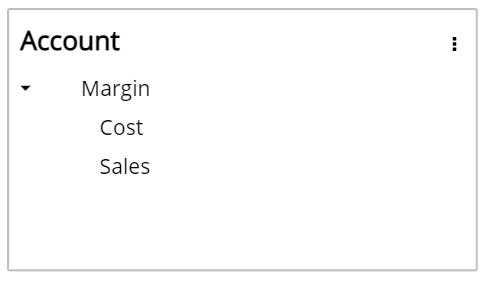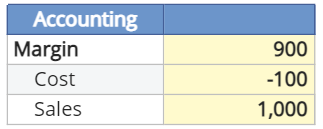Configure a Layout
You can configure a Layout in Design mode or edit an existing Layout in Play mode.
A Layout configured and saved in Design mode defines the associated Object default data configuration the end user will interact with.
An existing Layout can be edited in Play mode in order to change the data configuration of the associated Object and perform new analyses. A Layout edited in Play mode won't be saved permanently into the Capsule: refreshing the Screen or closing the Capsule will result the loss of all changes. However, the end-user can use the My Screen View feature in the Top Menu or add a Screen to a Presentation in order to save a customized Layout.
Users associated with any license can edit a Layout in Play mode, provided the appropriate Screen property is set to allow so. See Screen properties for more details.
To configure a Layout in Design mode, select an Object and click on the Layout icon (![]() ) in the Top Menu. You can also open the Layout editor by hovering over the Object and clicking on the contextual menu icon (
) in the Top Menu. You can also open the Layout editor by hovering over the Object and clicking on the contextual menu icon (![]() ) that appears in the upper left corner.
) that appears in the upper left corner.
To configure a Layout in Play mode, hover over the corresponding Object and click on the contextual menu icon (![]() ) that appears in the upper left corner.
) that appears in the upper left corner.
Depending on the Object the Layout is associated with, the Layout editor may have slightly different features and configurations available.
The instructions below suggest an optimal configuration workflow and assume that the required Cubes, Entities and Relationships in the target Data Model have already been created and populated with data.
Once the Layout editor is open, proceed as follows:
- (Optional, but recommended) Give your Layout a title
- Select a target Data model (required only in case the multiple Data models mode is enabled in the Screen Properties)
- Apply a Layout Selection that applies only to the Layout (optional, but recommended in case you're working with highly granular Cubes with many dimensions in order to avoid slowdowns during calculations). Click on "LAYOUT" to bring up the Select configuration pop-up window.
If a Selection has been applied on a Screen in Design mode, the Layout will automatically inherit it. Its configuration will be displayed in the Layout Selections area, beside the "SCREEN" black label. See About the Select for more details.
- Create Data Blocks. Drag and drop Cubes, column algorithms, rules, ranking functions, Entities and Relationships from the Data panel on the left to the Data area on the right. You can also create Data Blocks by clicking the "+" button below the Data area.
To create a Data Block defined by a column algorithm, drag and drop the Algorithm placeholder from the "MORE" tab of the data panel to the Data area or click the "+" button below the Data area and select the Algorithm iconThe first Data Block of a Layout must be a Cube or an Algorithm.
Click on a Data Block to reveal the Block settings panel on the right-hand side of the page. Click the "Filters" button to configure sorting options and filtering conditions based on Data Block values.
You can change the Data Blocks order by dragging and dropping them to a different position in the list. To do so, hover over the letter displayed in the row header of the desired Data Block to start dragging it.
The maximum number of Data block you can add to a Layout is 169.
If you add an algorithm as a Data Block, two scenarios may occur:
1 - If the arguments for the formula include other Data Blocks (for example, "a-b"), the algorithm Block is displayed for all Entities set by column in the Layout
2 - If the arguments for the formula do not include other Data Blocks or no formula has been entered, the algorithm Block is only displayed once -
Configure the Axis area. Set Entities in rows and columns by dragging and dropping them from the Data panel on the left to the "BY ROW" and "BY COLUMN" fields in the Axis area on the right. Click the "Settings" button to configure additional Axis settings in the panel on the right-hand side of the page
When you add multiple Entities by row, Board automatically detects the grouping: the most nested Entity in a Relationship is arranged in the rightmost position in the "BY ROW" field.
You can rearrange the Entities order in each of the two fields only if those Entities are unrelated. To do so, drag and drop them in the desired position. -
Check the Object preview pane and click the "Settings" button to configure additional Layout settings in the "Object properties" panel on the right-hand side of the page
The preview will update every time the Layout configuration is changed.
Depending on the Object the Layout is associated with, the "Object properties" panel may have different features and configurations available. -
Once the Layout Configuration is complete, you can:
-
Click on "SAVE" to apply all changes. The Layout editor will close and the Layout is refreshed to immediately reflect the changes
-
Click on "APPLY" to apply all changes and close the Layout editor without executing the Layout
-
By default, when RAM saturation exceeds 85%, Layout executions that have been running for more than 5 minutes are aborted. Both the RAM saturation threshold and the Layout execution timeout can be configured via the RamSaturationPercentage and the LayoutExecutionMinutesTimeout parameters, respectively.
- On-premises installations. The RamSaturationPercentage and the LayoutExecutionMinutesTimeout parameters have been added to the server_config_v2.xml file that can be found in the path C:\Program Files\Board\Board Server\ on the machine where the Board Server has been installed
- Cloud subscriptions. For Cloud customers, custom configurations can be applied by raising a ticket through the Board Support Portal. The ticket must contain your Platform name (e.g. customer1-s1.board.com). The Board Cloud Operations team will then handle your request
The Out of memory management system applies to all Layouts, except those configured in "Extract" Procedure steps and in the R Calculation step.
When Layouts get stopped by the Out of memory management system, they are logged in the RamSaturationActions log.
Unbalanced hierarchy in the “BY ROW” field
Once the Entity that contains the unbalanced hierarchy is added in the “BY ROW” field in a Layout, values are aggregated on-the-fly along the roll-up hierarchy.
The items displayed in the Layout are those selected in the Select filters. Note that the on-the-fly aggregation is not affected by the Select filters therefore the values of parent items doesn't vary if you Select or Exclude one or more children. The Select filters only affect which rows are returned by the Layout.
For example, let’s consider a hierarchy made up of three members:

In this scenario, Margin is parent of both Cost and Sales.
The data saved at physical level within the Cube are the following:
- Cost -100
- Sales +1000
The corresponding Data View will show the following values:

By selecting Margin and Cost only, the Data View will show the following values:

When the Entity that contains the unbalanced hierarchy is added in the “BY ROW” field in a layout, it is also possible to apply Rules and Nexel formulas to it.
Layout with Unbalanced hierarchies, Rules and Algorithms
If a Layout includes algorithm Blocks and Blocks with Unbalanced hierarchies on which Rules have been applied, values are calculated following the sequence described below:
- In non-algorithm Blocks with Unbalanced hierarchies, Parent members are calculated based on child members
- Rules are executed
- Algorithms are calculated. In case of Blocks with Unbalanced hierarchies, they're calculated on child members
- Algorithms are calculated on parent members for Blocks with Unbalanced hierarchies
In case an algorithm Block refers to a Block with an Unbalanced hierarchy and a Rule applied to it, to have the algorithm calculated on the values resulting from said Rule you can:
- Apply the same Rule to the algorithm Block
- Disable the Unbalanced hierarchy on the algorithm Block
Entity in a Select
Suppose the Entity that contains the unbalanced hierarchy is not in the “BY ROW” field in a layout, but you've selected a parent using a Select: the layout will show the total sum of that parent’s children values.
In the previous example, by selecting Margin, the Data View will show the total sum of 900.

Improve performance of a Layout execution
To optimize RAM consumption, a runaway query protection system is available in order to reduce the memory usage for a Layout execution which improves Board’s overall performance. The runaway query protection system is disabled by default, but can be enabled to kill queries that generate more than a specific maximum number of cells. The runaway query protection system does not apply to "Extract" Procedure steps, the Dataflow step, the R Calculation step and all requests coming from Office add-ins.
Learn how to:
- Add Blocks
- Configure Blocks
- Configure Axis area settings
- Use Layout filters
- Use the Select in a Layout